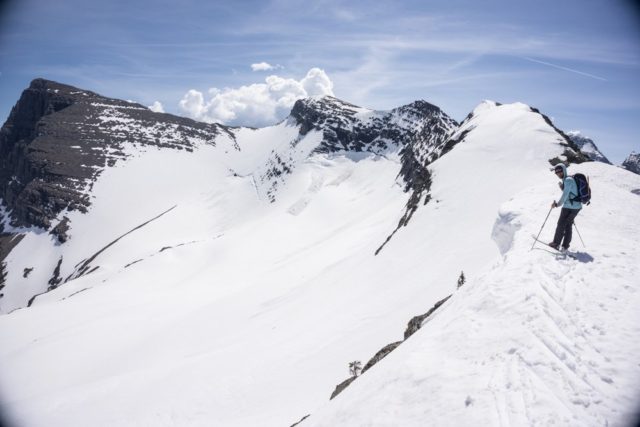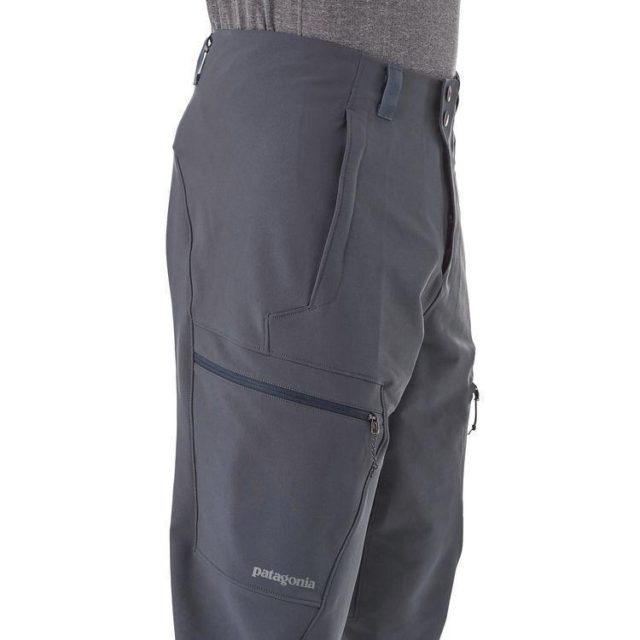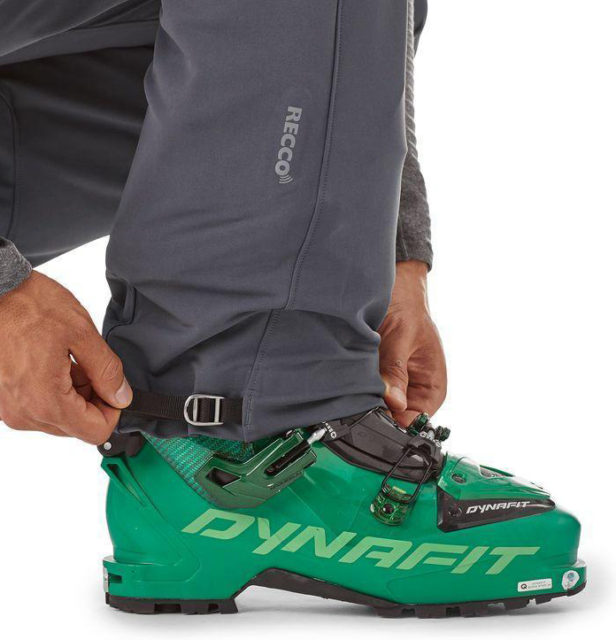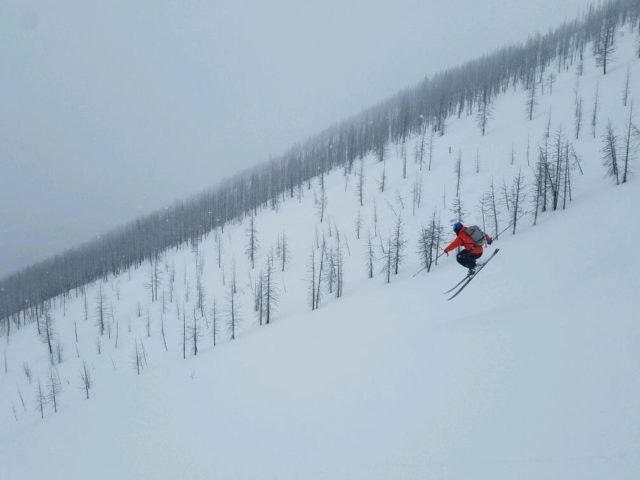
Patagonia Snowdrifter Pant
Reviewer: 5’8”, 195 lbs
Size Tested: Large
Stated Weight: 584 g (20.6 oz)
Blister’s Measured Weight: 497 grams (17.5 oz)
Material: 8.1-oz 50% nylon / 43% polyester / 7% spandex stretch woven with a DWR (durable water repellent) finish
Stated Features:
- Clean, flat waist sits comfortably under a pack and separates with a snap closure and zip fly; webbing loop on rear yoke attaches pants to the powder skirt on any Patagonia® Snow jacket
- Removable, elasticized suspenders increase mobility without pants riding up
- Articulated patterning complements generous stretch for exceptional mobility while stepping or sliding
- Two welted front pockets and two large thigh pockets; secure closure with DWR-coated zips
- Single-cuff design adjusts snug around boots with a webbing metal buckle that adjusts easily with gloved hands
- Concealed RECCO® reflector
Pockets:
- Two hand (zippered)
- Two Thigh (zippered)
MSRP: $229
Days Tested: 15
Test Locations: Whitefish Mountain Resort, Northwest Montana Backcountry, Downing Mountain Lodge, Missoula Snowbowl, & Glacier National Park, Montana
[Editor’s Note: The Snowdrifter Pant was discontinued for the 18/19 season and replaced by the Patagonia “Snow Guide Pant,” which is identical apart from the addition of internal gaiters, rear thigh vents, and new colorways.]
Intro
Patagonia describes their Snowdrifter pants as “[c]lassic soft-shell pants for off-piste purists and guide professionals” and say their design “emphasizes motion and attention to descent-oriented details.” I’ve spent a good deal of time touring in the Snowdrifter pants to see how they would handle both the uphill and downhill aspects of ski touring, and to see how they compare to several of the other soft shell touring pant options on the market.
Fit
The Snowdrifter is built on Patagonia’s “Regular” fit block. Like other “Regular” fit Patagonia pieces I’ve used, the Snowdrifter is pretty loose, comfortable, and baggy compared to other touring-oriented pants like the Arc’teryx Procline FL. The Snowdrifter is on the wider side in the waist for a Large (36” stated waist circumference for a Large). Through the thighs, the Snowdrifter is slim but with a bit of extra room, and it has plenty of extra fabric around the knees and lower leg.

I have been frustrated with the Snowdrifter’s looser fit through the lower legs, as it makes for extra fabric to snag in bindings and on crampons. The Snowdrifter is by no means some skin-tight skimo pant.
With that said, the combination of the Snowdrifter’s stretchy fabric and looser fit do make for plenty of freedom of movement.
Fabric and Breathability
It’s hard to overstate how comfortable these pants are, and given that they don’t have a lining, it’s all due to the fit and fabric itself. The nylon / polyester / spandex fabric is super soft on the skin, feels smooth while skinning, and provides stretch like a skimo suit while looking much cooler.
The comfort of the fabric on the Snowdrifter generated the term “technical loungewear” in my household. Just because I’m inside, that doesn’t mean I don’t enjoy good patterning, breathability, comfy fabrics, or a DWR on my layers. This makes the Snowdrifter perfect for spring hut trips where you’re living in your soft shells, and not just touring in them.

The Snowdrifter has no dedicated venting, which means that its breathability therefore comes entirely through the fabric itself and the mesh-backed pockets. Overall, I was impressed by the Snowdrifter’s breathability on several hot, spring days. Though I was still sweating, the pants were breathable enough to move moisture through to the outside while still cutting out enough wind to keep me happy. I think all but the sweatiest of folks will find the Snowdrifter to be plenty breathable.
Weight and Packed Size
Unsurprisingly, the Snowdrifter’s aim towards dedicated backcountry users and guides comes in a lightweight package at 497 grams for the Large. Packed down, the Snowdrifter is a bit smaller than a Nalgene.
For reference, here are a few of our measured weights (in grams) for some other notable pants:
439 Strafe Recon Pant, size Medium
497 Patagonia Snowdrifter Pant, size Large
534 Patagonia Descensionist Pant, size Large
538 Norrona Lyngen Hybrid Pant, size Medium
580 Mountain Equipment Mission Pant, size Medium
627 Mountain Equipment Spectre Pant, size 34” Regular
658 Arc’teryx Procline FL Pant, size Large
697 Mammut BASE Jump Touring Pant, size Medium
Features and Pocketing
A few features on the Snowdrifter are worth mentioning. The included, removable suspenders are nice and easily adjustable, though I personally decided to ditch them for a belt (the pants do not include a belt, but do have belt loops).
The Snowdrifter’s pocket layout is great. Up top, two welted and zippered hand pockets hold a phone, key, snack etc. The interior of these pockets is a comfy mesh, which means they can also work as vents if left open while skinning.

Both thigh pockets on the Snowdrifter are located on the outside of the leg. One thigh pocket has a stretchy loop in it, which I used to attach my beacon lanyard, though where you stash your beacon is up to you. An avie fieldbook fits comfortably in the other thigh pocket, and because the thigh pockets aren’t directly on the front of the thigh, I could move around without the objects in the pockets getting in the way of leg movement. The one issue I’ve had with the pockets is that one of the thigh pocket zippers has snagged closed, leaving me with one less storage option.
Perhaps the most significant feature of the Snowdrifter is the cuff cinch. Instead of elastic, cord, or velcro, Patagonia went with an external webbing cinch strap with a metal buckle. Visually, it looks clunky, but functionally, it’s the most durable and consistently tensioned cuff closure system I’ve used. Post-holing through crusts and isothermal slush was not a problem, and fitting the pant bottoms to approach footwear works fine. Occasionally, the strap would wet and ice up, making it harder to adjust, but this was rare.

Weather Resistance
The Snowdrifter’s fabric doesn’t have a membrane and is not seam sealed, and as a result, these aren’t the pants that I’d recommend for days when much precip is in the forecast. Skinning with the Snowdrifter in a snowstorm on our last day at Downing Mountain Lodge caused the thighs to wet out a bit, but once the snow had stopped, they dried out after about two hours. I’d call the Snowdrifter’s fabric less water-resistant than some of the heavier soft shell fabrics I’ve used, particularly the Burly Doubleweave on the Arcteryx Procline FL pant and the Windstopper soft shell on Mountain Equipment’s Spectre pant.

When it comes to blocking wind, the Snowdrifter does fairly well. I’d call its windproofing mid-range for a soft shell — the Snowdrifter doesn’t block all the wind, but it doesn’t let gusts right through, either.
Durability
Fifteen days is hardly enough time to give a really good test of long-term durability, but the only issue I’ve seen yet on the Snowdrifter is the thigh pocket zipper snagging closed. I’ve gone at it with multiple pairs of pliers, yet it simply won’t come undone. I’ll update this review once I hear from Patagonia about the potential warranty repair options for the pocket.
Who’s It For?
Back to the main question: are the Snowdrifter pants worthy of the “off-piste purist?” I’d say so, particularly if that person is looking for a no-nonsense, comfortable, everyday pant for touring when there isn’t much precip in the forecast. Those looking for something to cross over to the resort would probably be better off with more weather-resistant options, and those looking specifically for a soft shell pant that can handle more precip should check out pants with thicker, heavier fabrics like the Arc’teryx Procline FL or Mountain Equipment Spectre.
Bottom Line
Backcountry skiers looking for a soft shell touring pant that prioritizes simplicity, comfort, and breathability over weather resistance should certainly check out the Snowdrifter.

Hey i think that that is the Patagonia Snow Guide Pant as it has the same material composition as the Snow Guide and the same cuff system. I don’t think they don’t make a Snow drifter pant or at least it currently isn’t on their website. Just trying to help, love all the stuff you guys produce easily the best review and gear discussion group out there and you podcasts make the days fly by!
Hi Adam,
Thanks for the note, and the kind words. The pant we reviewed was called Snowdrifter, which was in the Patagonia line last year. We reached out to Patagonia and confirmed that the Snow Guide pant (which replaced the Snowdrifter this year) is extremely similar to the Snowdrifter. Apart from the name change, Patagonia said the most notable updates are the addition of internal gaiters and rear thigh vents. I’ll add a note at the top of the review for clarification.
Cheers,
Luke